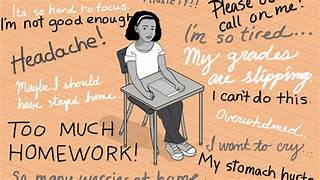Addressing Mental Health Challenges in High School Students
Mental health challenges among high school students are becoming increasingly prevalent, and addressing these challenges is crucial for their overall well-being and academic success. Adolescence is a time of immense change, and students often face pressures from various aspects of life, including academic performance, social relationships, family dynamics, and the evolving challenges of adolescence itself. The prevalence of mental health issues, such as anxiety, depression, and stress, has risen significantly, yet it remains a topic that is often overlooked or stigmatized. It is essential that we, as a society, acknowledge the importance of mental health and take active steps to provide high school students with the resources and support they need. In this article, we will explore the common mental health challenges faced by high school students, the signs to look out for, and practical strategies for addressing these issues both at school and at home.
1. Understanding the Mental Health Challenges Faced by High School Students
High school students are under constant pressure, whether it be from academic demands, peer relationships, or societal expectations. These pressures can lead to mental health challenges, which can have serious repercussions if left unaddressed. Common issues include anxiety, depression, stress, and feelings of isolation.
Common Mental Health Issues:
- Anxiety: Many students face overwhelming stress related to schoolwork, extracurricular activities, and social pressures. This can lead to feelings of anxiety and panic attacks.
- Depression: Depression is another prevalent issue, with students often feeling sad, hopeless, or unmotivated.
- Stress and Burnout: Academic pressures, combined with extracurricular activities, can result in overwhelming stress and burnout.
- Social and Peer Issues: High school is a time when students navigate complex social dynamics, and issues like bullying or difficulty making friends can contribute to mental health challenges.
Understanding these issues is the first step in helping students overcome them.
2. Recognising the Signs of Mental Health Struggles
The first step in addressing mental health challenges is to recognise the signs that a student may be struggling. Mental health issues are often not immediately visible, so it is important for teachers, parents, and peers to be vigilant and proactive in identifying early warning signs.
Warning Signs to Look For:
- Changes in Behaviour: A noticeable shift in a student’s behaviour, such as withdrawal from social activities or a decline in academic performance, can be a sign of mental health struggles.
- Physical Symptoms: Students experiencing stress, anxiety, or depression may report headaches, stomachaches, or fatigue, which could indicate emotional distress.
- Emotional Changes: Sudden mood swings, irritability, or excessive sadness are all common signs of mental health issues.
- Social Withdrawal: A student who isolates themselves from friends or extracurricular activities might be experiencing mental health challenges.
- Decreased Interest in Schoolwork: A sudden drop in academic performance or a lack of interest in school activities can indicate emotional difficulties.
Early intervention is key to providing the necessary support and resources to students who may be struggling.
3. Providing Support in the School Environment
Schools play a pivotal role in addressing mental health issues, as they are where students spend a significant portion of their time. Creating an environment that supports mental well-being can help students feel safe and understood, making it easier for them to seek help.
Supportive Strategies for Schools:
- Mental Health Education: Incorporate mental health awareness into the curriculum to reduce stigma and teach students about the importance of mental well-being.
- Access to Counselling Services: Ensure that students have access to school counsellors who can provide confidential support for students dealing with mental health challenges.
- Peer Support Programs: Develop peer mentoring or buddy systems where students can support one another and help reduce feelings of isolation.
- Promoting Stress Relief Activities: Offer activities like mindfulness, yoga, or relaxation techniques to help students manage stress in a healthy way.
- Open Communication Channels: Encourage open discussions about mental health through workshops, assemblies, and classroom discussions to make it easier for students to express their struggles.
By fostering an environment where mental health is taken seriously, schools can support students in overcoming challenges.
4. Encouraging Open Conversations About Mental Health
One of the main barriers to addressing mental health challenges in high school students is the stigma surrounding mental health. Students may feel embarrassed or ashamed to ask for help, and this can prevent them from seeking the support they need. Encouraging open conversations about mental health can break down this stigma and normalise seeking help.
How to Encourage Open Conversations:
- Normalise Mental Health Talks: Encourage students to talk openly about their feelings by incorporating mental health topics into classroom discussions.
- Provide Resources for Students: Make sure students are aware of the resources available to them, such as school counsellors, hotlines, and mental health apps.
- Involve Parents and Teachers: Parents and teachers should play an active role in having open conversations with students about their emotional well-being.
- Create Safe Spaces: Ensure that students know there are safe, confidential spaces where they can discuss their mental health concerns without fear of judgment.
Creating a culture where mental health is not a taboo subject allows students to feel more comfortable seeking help.
5. Teaching Coping Mechanisms and Stress Management
Helping students develop healthy coping mechanisms and stress management skills can significantly improve their ability to handle mental health challenges. It’s essential that schools and parents teach students how to manage their emotions and stress in healthy ways.
Effective Coping Strategies to Teach Students:
- Mindfulness and Meditation: Teach students mindfulness techniques to help them stay grounded and reduce stress.
- Physical Activity: Encourage regular physical activity, as exercise has been shown to reduce symptoms of anxiety and depression.
- Time Management Skills: Help students manage their workload and avoid burnout by teaching them effective time management techniques.
- Journaling and Self-Reflection: Encourage students to keep a journal to express their emotions and reflect on their experiences.
- Breathing Exercises: Teach deep breathing exercises as a quick and effective way for students to calm themselves in stressful situations.
By equipping students with these skills, they can better cope with stress and emotional challenges.
6. Providing Family Support and Involvement
Mental health challenges do not only affect students; they also affect their families. Parents and guardians play an important role in supporting their children’s mental health, and it is essential that they are involved in the process. Schools should provide resources and guidance for families to ensure they are equipped to support their children effectively.
Ways to Support Families:
- Parent Education: Offer workshops and resources to educate parents on how to recognise the signs of mental health struggles and how to support their children.
- Family Therapy: Encourage families to engage in therapy together if needed, to improve communication and provide a supportive environment.
- Regular Communication with Parents: Schools should maintain open lines of communication with parents to keep them informed about their child’s mental health and progress.
When families are involved in supporting their children, students are more likely to feel understood and supported.
7. Leveraging Technology for Mental Health Support
In today’s digital age, technology can be a powerful tool in addressing mental health challenges. From mental health apps to online therapy services, there are a variety of ways that technology can support high school students.
How Technology Can Help:
- Mental Health Apps: Apps like Calm, Headspace, and Moodpath can help students practice mindfulness, manage their mood, and track their mental health.
- Online Therapy Services: Some students may feel more comfortable seeking help through online therapy platforms, which provide convenient and confidential support.
- Virtual Support Groups: Virtual support groups can provide students with a sense of community and allow them to share experiences with others facing similar challenges.
By incorporating technology into mental health support, students can access resources that may otherwise be difficult to obtain.
8. Raising Awareness Through School-Wide Campaigns
Raising awareness about mental health issues through school-wide campaigns can help reduce stigma and encourage students to seek help when needed. These campaigns can also promote resources available to students and create a culture of understanding and support.
Effective Campaign Ideas:
- Mental Health Awareness Week: Host events, workshops, and discussions to raise awareness about mental health.
- Student-Led Initiatives: Encourage students to lead initiatives such as peer support groups, awareness campaigns, or mental health first aid training.
- Poster Campaigns: Use posters and digital displays around the school to share information about mental health resources and coping strategies.
Awareness campaigns help to create a culture where students feel supported and comfortable talking about mental health.
Conclusion
Addressing mental health challenges in high school students requires a collective effort from schools, families, and communities. By recognising the signs, providing support, encouraging open conversations, and teaching coping strategies, we can help students manage their mental health and thrive both academically and emotionally. Mental health should not be a taboo subject, and with the right resources and support, students can overcome challenges and lead fulfilling, successful lives.
FAQs
1. What are the most common mental health issues among high school students?
The most common issues include anxiety, depression, stress, and burnout, all of which are often exacerbated by academic pressures and social dynamics.
2. How can teachers identify if a student is struggling with mental health?
Teachers should look for signs such as changes in behaviour, withdrawal from activities, a decline in academic performance, and emotional fluctuations.
3. What can parents do to support their child’s mental health?
Parents can maintain open communication, encourage healthy coping mechanisms, and seek professional help if needed. It’s important for them to be supportive and understanding.
4. How can schools create a more supportive environment for mental health?
Schools can implement mental health education, provide counselling services, encourage peer support, and foster a culture of open communication.
5. How can technology be used to help students with mental health challenges?
Mental health apps, online therapy services, and virtual support groups are all ways technology can provide students with accessible and confidential mental health support.
6. How can students cope with academic stress?
Students can manage academic stress by learning time management skills, practising mindfulness, engaging in physical activity, and seeking support when needed.
7. What role does peer support play in addressing mental health challenges?
Peer support is vital as students are more likely to open up to their friends. Peer mentoring programs can create a sense of community and reduce feelings of isolation.






